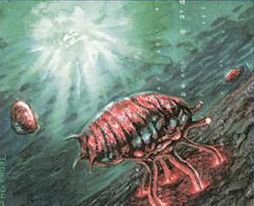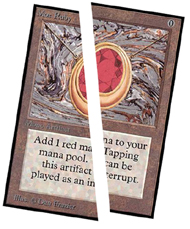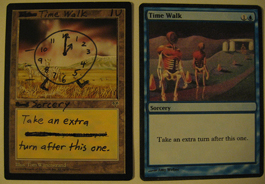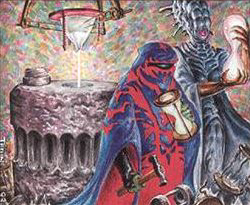
Your First Vintage Tournament
by David Earley
by David Earley
Going to your first Vintage tournament can be a daunting experience. Because most Vintage tournaments are unsanctioned, the procedures that will be used at any one event may be uncertain, even through the course of the event itself. Beyond this, there are a few things that set the Vintage community apart from the rest of the Magic world. If you are interested in learning about this format and its community, I encourage you to read on. While there are some negative aspects to Vintage that I am going to point out, I do not want them to be the focus of the article. Instead, I am trying to point out potential issues so that you will not be caught off guard by them, should they arise. Overall, Vintage is a very rewarding and interesting format, both in terms of the decks you will face and the players you will meet.
The Vintage community is comprised of an exceptional group of people. The vast majority (90%) of Vintage players are at least 18 years old, and most have been playing for at least a few years. Some have been playing since the inception of Magic itself. At a typical tournament, you will find both fairly laid-back players who will play hard but do not care whether they win or lose. You will also find over-the-top almost too competitive players (like me). The point is that you will fit in regardless of where you fall on this spectrum. Vintage is not an exclusive club by any means, in spite of the somewhat larger barrier to entry (relative to other formats) created by the extensive card pool. What is better, though, is that once you’re in, you’re in for good; your cards will generally retain their full value over time and may even go up in value. Beyond this, if real life issues become a concern, you can very easily exit the game for months at a time and reenter, with virtually no real setback in terms of collection value or play skill. As a great example, though Steve O’Connell, founder of TheManaDrain.com very recently came back from a two year hiatus; it is as if he never left. Though there are teams, they interact on a regular basis, both online and in person. The camaraderie is something you will have difficulty finding anywhere else in this game.
So, why even write about Vintage tournaments? How are they different from any other tournament? Well, they’re different in a lot of ways that may be unknown to the uninitiated. The single most defining aspect of Vintage tournaments is the fact that they are unsanctioned. However, it must be understood that this is not be a bad thing! In fact, it is actually a good thing. The unsanctioned nature of Vintage tournaments is really what allows them to flourish. This is because in an unsanctioned environment, players are allowed to run proxies. Proxies are cards that are used as a substitute for another card, typically because that card is very expensive. In this way, people can play with very rare cards they do not actually own and therefore be competitive with those who do own them. Additionally, the number of people who can have these cards expands. Inquest stated at one point that only 40,000 Black Lotuses were minted. This number is even relatively lower for Mishra’s Workshop if you consider the fact that each player needs four of them rather than only one; there are fewer Mishra’s Workshop playsets than Black Lotuses. While I could address the issue of whether proxies are unethical toward players who own the actual cards, that is not the point of this article. I just want you to be aware of the rationale for Vintage being unsanctioned.

The ultimate source for Vintage.
Ok, so you’ve found an event that you’re interested in. However, do you really want to attend? Well, that too depends on your personal tastes. The entry fee might be a concern, especially if you’re driving a significant distance. Fees generally range from $10-$35. While this may seem steep just to play Magic, the reason for this is to support Vintage’s prizes. Prizes are one of the more significant driving forces of Vintage tournament attendance (although I’m sure some people would argue about this with me). As might be expected, bigger entry fees are generally synonymous with bigger prizes.
There are a number of things to be aware of when it comes to prizes, however. First, just because a tournament advertises that it is a “Mox Sapphire tournament” does not mean you will actually be playing for that when you get there. Why? Because the tournament may have a prize structure based upon attendance. To play for the “big prize,” attendance generally has to be around 20 people. While this is by no means the norm, some tournaments will actually list a prize structure based upon attendance they know they have a very slim chance of acquiring. Consequently, you may end up playing for a much smaller prize, such as Mana Drain or a foreign black bordered dual land. In my own experience, I went to a Time Walk tournament where we ended up playing for a Mana Drain in a pitiful three rounds of swiss because of the poor attendance. Fortunately, I was already in the area, but had I not been, this could have been a very bad day. Try to get a feel for how many players are expected; that way you can have a reasonable idea of what you will be playing for once you get there.
Second, how is the prize structure divided up? This point is not as significant as the first, but is still something that should be discussed. Basically, you’re going to find two types of prize structures: top heavy and evenly distributed. In an evenly distributed structure, you’ll find that the difference between the biggest prize and the smallest prize is not too significant, perhaps $50-$75 difference. In a top heavy tournament, there will most likely only be one or two prizes. Consequently, if you do not do really well, you will leave with nothing. For some people this is great; if they play well one day they want to be rewarded big time. For others, however, having a good but not amazing day and leaving with nothing can be disappointing (I’m one of these people).

I’ll take the right half.
While all this talk of prizes is nice and all, you may not even have a deck yet. Building your deck essentially has two parts: deciding what to run and proxying cards you do not own. As is the case in other constructed formats, Vintage has a minimum deck size of 60 cards and no maximum. In Vintage, you are allowed to run four copies of almost any Magic card that has been printed, as long as it has a standard Magic: the Gathering back and does not have a silver or gold border. This implies that cards from all of the Portal and Starter expansions in addition to compilation expansions, such as Chronicles and Anthologies, are all legal. Un-set and collector’s edition cards are not allowed. Beyond this, your deck is also only allowed to run one copy of each card on the Restricted List and zero copies of any card on the Banned List. The lists are typically updated on the first day of every month divisible by three.

Selecting the right deck can be a difficult decision.
So you’ve decided which deck you want to play, but you do not own all those thousands of dollars worth of Magic cards. Not a problem! Fortunately for you, the vast majority of Vintage tournaments (even the high level ones) allow the use of proxies. Most American sites will allow 10-15 proxies (the precise number is specified in the tournament announcement), although some tournaments have been known to allow unlimited proxies. Outside the United States, though, they tend to be more restrictive with the use of proxies. Generally you can proxy any card you want (including cards from recent sets), although some sites specify other guidelines. Regardless, know the allowable number and tailor your deck accordingly. For the sake of completion, note that proxies are not permitted in the annual Vintage World Championship, a sanctioned tournament at GenCon.

An ordinary proxy next to an exceptional proxy.
Most of your major concerns about the actual tournament should end there. However, there are a few more things worth mentioning. First, because Vintage tournaments are unsanctioned, oftentimes there will not be a person acting solely as a head judge, especially if you are at a small event. While the reasons for this are complicated, suffice it to say that it does happen. This will never be the case at a large event, however. There are a few ways that this lack of a judge can be handled: 1) you will have a player who acts as the head judge, 2) judging decisions are made by the tournament coordinator (who may or may not know proper Vintage rules), or 3) judging decisions are decided on the spot by the tournament field at large (literally by yelling out the scenario to the masses). While this may seem like a big deal, it really is not, primarily because Vintage players are generally mature adults who know the rules. While there are exceptions, it is a rare occasion where the lack of a judge significantly impacts the outcome of a match. In my five or six years of playing in Vintage tournaments, I have had only one incident where the lack of a judge possibly changed the outcome of the match. That being said, just be aware that there may not be a judge at your event. Additionally, in spite of what I said earlier, do not blindly trust your opponent; he may be one of the slimy ones. If you have a question, ask.

This guy will most likely not be judging your event.
Speaking of expensive decks, you will almost certainly see some exceptionally expensive decks, even by Vintage standards. By this, I mean you will see “pimped” decks packing countless Asian foils with artist signatures and more black borders than you can shake an Isochron Scepter at. Do not let this intimidate you (although I know it intimidated me at my first tournament). While they may have the more expensive versions of cards, their cards are exactly the same as yours in terms of power, whether they are Beta or Ninth Edition. It’s how you use it, not what it looks like. Additionally, do not take the pimpage of one’s deck as an indicator of one’s playskill. In my experience, there is rarely any correlation between the two. One thing worth mentioning on this note, though, is that if you are unsure about what a card does because it is printed in a language you cannot read, ask someone what it does (whom you ask will largely depend on your own situation).
In your first Vintage tournament, there are a few rules situations that you are likely to encounter on a regular basis that you should be aware of and know how to handle. While there are plenty that I could have included here, I am just including the most important and most common ones. You ought to read what each card does by clicking on its name before reading the explanations.
Mana Drain is something you will almost certainly see. The trick here has to do with “next main phase.” If a player Mana Drains something during his first main phase or during his combat phase, then he will get the extra mana during his second main phase of the same turn. If he Mana Drains any other time, then he will get the mana at the beginning of his next first main phase. This is important to be aware of, as players sometimes forget what phase they are on and then make play errors or rules errors as a result. Just be aware of what the text of Mana Drain implies about its functionality. Additionally, the proper time to Stifle Mana Drain is at the beginning of the phase the mana would be added, not after Mana Drain resolves.
Mana Crypt is a card you may or may not see. Just remember to actually go through with the coin flip (commonly a die roll of even or odds) when Mana Crypt’s controller’s upkeep comes. Many a Crypt flip has been forgotten over the years. It is also probably best that one player call and one player roll (while the rules say that the opponent of Mana Crypt’s controller is supposed to roll while the controller calls, nobody is going to scream “judge” if you do it another way). Also the rules have recently changed to allow a player to put an object of some sort (a glass stone or a die) on top of his deck as a reminder for upkeep effects. Feel free to do this if it will help you remember your own Mana Crypt rolls (placing an object on your opponent’s deck might not go over so well).
Tangle Wire and Smokestack are two cards you might see on tournament day, although Stax is an out-of-favor archetype as of the time of this writing. The importance here has to do with how the triggers are stacked. The long and the short of it is that the controller of these two permanents is able to fix the stack such that he abuses the cards as extensively as possible. During his turn, he can make the stack (from top to bottom): Tangle Wire remove a counter, Tangle Wire tap permanents, Smokestack sacrifice permanents, Smokestack add a counter. So, he gets to sacrifice fewer tapped cards and doesn’t suffer the wrath of the new soot counter. During his opponent’s turn, he can make the stack (from top to bottom): Smokestack sacrifice a permanent, Tangle Wire tap permanents. His opponent gets the raw deal both ways. Of note, possibly, is that some people will try to sort of fudge the situation when someone says “I’ll put X on the stack first and Y on second” when he really means “I want X to resolve first and Y to resolve second.” While you might be able to argue this with the “judge,” it is probably best to just let the optimal play stand, as you know what he meant. If you want to be a rules lawyer though, be my guest.

When Worldgorger Dragon comes into play,
destroy target judge’s day. It can’t be regenerated.
The Storm mechanic, most commonly found on Tendrils of Agony in Vintage, is something you need to have a firm grasp of. The rules themselves on their face are not that complicated:
502.30. Storm
502.30a Storm is a triggered ability that functions while the spell is on the stack. “Storm” means “When you play this spell, put a copy of it onto the stack for each other spell that was played before it this turn. If the spell has any targets, you may choose new targets for any number of the copies.”
502.30b If a spell has multiple instances of storm, each triggers separately.
There are a few things to note. First, it counts all spells played thus far, including the opponent’s spells. Second, Storm only looks for spells played not just spells put on the stack. So, a Storm spell won’t see the copies of other Storm spells in determining its Storm count. Third, countering the original will not stop the copies. You need to Stifle, Trickbind, or somehow otherwise deal with the triggered ability instead. If you have further questions about Storm, I suggest that you ask in the rulings forum.502.30a Storm is a triggered ability that functions while the spell is on the stack. “Storm” means “When you play this spell, put a copy of it onto the stack for each other spell that was played before it this turn. If the spell has any targets, you may choose new targets for any number of the copies.”
502.30b If a spell has multiple instances of storm, each triggers separately.
A card you are unlikely to see, but need to be aware of how to handle is Chains of Mephistopheles. Rather than try to explain it here, however, I would just like to point you to this article on MagicTheGathering.com which gives an extensive explanation of how the card works. It is far more complete than any explanation I could offer here.
Finally, be aware of the errata of your cards (meaning, the current Oracle text), so that you are not surprised come tournament day. This can potentially save a lot of headaches down the road, especially if your combo turns out to not actually be a combo.
While I have outlined a ton of information here, I do not want to give the impression that playing in Vintage tournaments is something that is difficult; it is not. I simply wanted to be as thorough as possible in addressing the many concerns and questions that might come up. Vintage is an incredible format with literally endless possibilities. The people you will meet are unlike any you will find in any other format. Not to mention, playing Ancestral Recall on yourself is just fun, plain and simple. This is something you owe to yourself to try at least once. Though I was going to write this article without any strategy recommendations, I am going to leave you with this parting advice: Yawgmoth’s Will is almost always a must-counter.
Best of luck in your first Vintage tournament and hopefully many beyond!

Comments